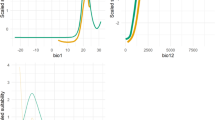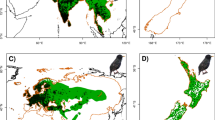Abstract
Despite their economic and environmental impacts, there have been relatively few attempts to model the distribution of invasive ant species. In this study, the potential distribution of six invasive ant species in New Zealand are modelled using three fundamentally different methods (BIOCLIM, DOMAIN, MAXENT). Species records were obtained from museum collections in New Zealand. There was a significant relationship between the length of time an exotic species had been present in New Zealand and its geographic range. This is the first time such a time lag has been described for exotic ant species, and shows there is a considerable time lag in their spread. For example, it has taken many species several decades (40–60 years) to obtain a distribution of 17–25% of New Zealand regions. For all six species, BIOCLIM performed poorly compared to the other two modelling methods. BIOCLIM had lower AUC scores and higher omission error, suggesting BIOCLIM models under-predicted the potential distribution of each species. Omission error was significantly higher between models fitted with all 19 climate variables compared to those models with fewer climate variables for BIOCLIM, but not DOMAIN or MAXENT. Widespread species had a greater commission error. A number of regions in New Zealand are predicted to be climatically suitable for the six species modelled, particularly coastal and lowland areas of both the North and South Islands.






Similar content being viewed by others
References
Anderson RP, Lew D, Peterson AT (2003) Evaluating predictive models of species’ distributions: criteria for selecting optimal models. Ecol Modell 162:211–232
Beaumont LJ, Hughes L, Poulsen M (2005) Predicting species distribution: use of climatic parameters in BIOCLIM and its impact on predictions of species’ current and future distributions. Ecol Modell 186:250–269
Brown WL (1958) A review of the ants of New Zealand. Acta Hymenopterologica 1:1–50
Carpenter G, Gillison AN, Winte J (1993) DOMAIN: a flexible modeling procedure for mapping potential distributions of plants, animals. Biodivers Conserv 2:667–680
Christian CE (2001) Consequences of a biological invasion reveal the importance of mutualism for plant communities. Nature 413:635–638
Clarke KR, Warwick RM (2005) Change in marine communities: an approach to statistical analysis and interpretation, 2nd edn. Plymouth Marine Laboratory
Crosby TK, Dugdale JS, Watt JC (1998) Area codes for recording specimen localities in the New Zealand subregion. N Z J Zool 25:175–183
Drake JA, Mooney HA, di Castri F, Groves RH, Kruger FJ, Rejmanek M, Williamson M (1989) Biological invasions: a global perspective. John Wiley and Sons, New York
Elith J, Graham CH, Anderson RP, Dudík M, Ferrier S, Guisan A, Hijmans RJ, Huettmann F, Leathwick JR, Lehmann A, Li J, Lohmann LG, Loiselle BA, Manion G, Moritz C, Nakamura M, Nakazawa Y, Overton J.McC, Peterson AT, Phillips SJ, Richardson K, Scachetti-Pereira R, Schapire RE, Soberón J, Williams S, Wisz MS, Zimmermann NE (2006) Novel methods improve prediction of species’ distributions from occurrence data. Ecography 29:129–151
Fielding AH, Bell JF (1997) A review of methods for the assessment of prediction errors in conservation presence/absence models. Environ Conserv 24:38–49
Guisan A, Thuiller W (2005) Predicting species distribution: offering more than simple habitat models. Ecol Lett 8:993–1009
Guisan A, Zimmermann NE (2000) Predictive habitat distribution models in ecology. Ecol Modell 135:147–186
Hartley S, Lester PJ (2003) Temperature-dependent development of the Argentine ant, Linepithema humile (Mayr) (Hymenoptera: Formicidae): a degree-day model with implications for range limits in New Zealand. New Zeal Entomol 26:91–100
Hijmans RJ, Cameron SE, Parra JL, Jones PG, Jarvis A (2005) Very high resolution interpolated climate surfaces for global land areas. Int J Climatol 25:1965–1978
Hölldobler B, Wilson EO (1990) The ants. Harvard University Press, Cambridge
Holway DA, Suarez AV (2006) Homogenization of ant communities in Mediterranean California: the effects of urbanisation and invasion. Biol Conserv 127:319–326
Holway DA, Lach L, Suarez AV, Tsutsui ND, Case TJ (2002) The causes and consequences of ant invasions. Annu Rev Ecol Syst 33:181–233
Landcare Research (2006) New Zealand ant distribution data. Accessed April 2006 http://www.landcareresearch.co.nz/research/biosecurity/stowaways/Ants/distribution/index.asp
Loiselle BA, Howell CA, Graham CH, Goerck JM, Brooks T, Smith KG, Williams PH (2003) Avoiding pitfalls of using species distribution models in conservation planning. Conserv Biol 17:1591–1600
Kaspari M, Alonso A, O’Donnell S (2000) Three energy variables predict ant abundance at a geographical scale. Proc R Soc Lond B 267:485–489
Korzukhin MD, Porter SD, Thompson LC, Wiley S (2001) Modelling temperature-dependent range limits for the fire ant Solenopsis invicta (Hymenoptera: Formicidae) in the United States. Environ Entomol 30:645–655
Kriticos DJ, Randell RP (2001) A comparison of systems to analyse potential weed distribution. In: Groves RH, Panetta FD, Virtue JG (eds) Weed risk assessment. CSIRO Publishing, Collingwood
Mack RN, Simberloff D, Lonsdale WM, Evans H, Clout MN, Bazzaz FA (2000) Biotic invasions: casues, epidemiology, global consequences, and control. Ecol Appl 10:689–710
Meynecke JO (2004) Effects of global climate change on geographic distributions of vertebrates in North Queensland. Ecol Modell 174:347–357
McGlynn TP (1999) The worldwide transfer of ants: geographical distribution and ecological invasions. J Biogeogr 26:535–548
Mooney HA, Drake JA (eds) (1986) Ecology of biological invasions of North America and Hawaii. Springer-Verlag, New York
Morrison LW, Porter SD, Daniels E, Korzukhin MD (2003) Potential global range expansion of the invasive fire ant, Solenopsis invicta. Biol Invasions 6:183–191
Nix H (1986) A biogeographic analysis of Australian Elapid snakes. In: Longmore R (ed) Snakes: atlas of Elapid snakes of Australia. Bureau of Flora and Fauna, Canberra
O’Dowd DJ, Green PT, Lake PS (2003) Invasional ‘meltdown’ on an oceanic island. Ecol Lett 6:812–817
Peterson AT (2003) Predicting the geography of species’ invasions via ecological niche modeling. Q Rev Biol 78:419–433
Phillips SJ, Dudik M, Schapire RE (2004) A maximum entropy approach to species distribution modelling. In: Proceedings of the 21st International Conference on Machine Learning. ACM Press, New York
Phillips SJ, Anderson RP, Schapire RE (2006) Maximum entropy modeling of species geographic distributions. Ecol Modell 190:231–259
Pimm SL, Bartell DP (1980) Statistical model for predicting range expansion of the Red Imported Fire Ant, Solenopsis invicta, in Texas. Environ Entomol 9:653–658
Puth LM, Post DM (2005) Studying invasion: have we missed the boat?. Ecol Lett 8:715–721
Roura-Pascual N, Suarez AV, Gómez C, Pons P, Touyama Y, Wild AL, Peterson AT (2004) Geographical potential of Argentine ants (Linepithema humile Mayr) in the face of global climate change. Proc R Soc Lond B 271:2527–2535
Sandland OT, Schei PJ, Viken A (eds) (1999) Invasive species and biodiversity management. Kluwer Academic Publishers, Dordrecht
Segurado P, Araújo MB (2004) An evaluation of methods for modelling species distributions. J Biogeogr 31:1555–1568
Stoker RL, Ferris DK, Grant WE, Folse LJ (1994) Simulating colonization by exotic species: a model of the red imported fire ant (Solenopsis invicta) in North America. Ecol Modell 73:281–292
Suarez AV, Tsutsui ND (2004) The value of museum collections for research and society. Bioscience 54:66–74
Suarez AV, Holway DA, Case TJ (2001) Patterns of spread in biological invasions dominated by long-distance jump dispersal: Insights from Argentine ants. Proc Natl Acad Sci 98:1095–1100
Suarez AV, Holway DA, Ward PS (2005) The role of opportunity in the unintentional introduction of non-native ants. Proc Natl Acad Sci 102:17032–17035
Sutherst RW, Maywald G (2005) A climate model of the Red Imported Fire Ant, Solenopsis invicta Buren (Hymenoptera: Formicidae): implications for invasion of new regions, particularly Oceania. Environ Entomol 34:317–335
Téllez-Valdés O, Dávila-Aranda P (2003) Protected areas and climate change: a case study of the Cacti in the Tehuacán-Cuicatlán Biosphere Reserve, México. Conserv Biol 17:846–853
Vega SJ, Rust MK (2001) The Argentine ant—a significant invasive species in agricultural, urban and natural environments. Sociobiology 37:3–25
Ward DF (2005) Changes to the classification of ants (Hymenoptera: Formicidae). The Weta 30:16–18
Ward DF, Harris R (2005) Invasibility of native habitats by Argentine Ants, Linepithema humile, in New Zealand. N Z J Ecol 29:215–219
Ward DF, Beggs JR, Clout MN, Harris RJ, O’Connor S (2006) The diversity and origin of exotic ants arriving to New Zealand via human-mediated dispersal. Diversity and Distributions. 12:601–609
Ward DF, Harris RJ, Stanley MC (2005) Human-mediated range expansion of Argentine ants Linepithema humile (Hymenoptera: Formicidae) in New Zealand. Sociobiology 45:401–407
Williams DF (1994) Exotic ants: biology, impact, and control of introduced species. Westview Press, Boulder Colorado
Williams PA, Cameron EK (2006) Creating gardens: the diversity and progression of European plant introductions. In: Allen RB and Lee WG (eds) Biological invasions in New Zealand. Springer-Verlag, London
Zaniewski AE, Lehmann A, Overton JMcC (2002) Predicting species spatial distributions using presence-only data: a case study of native New Zealand ferns. Ecol Modell 157:261–280
Acknowledgements
Many thanks to Richard Harris for access to database records, and to Steve Phillips and Robert Hijmans for their assistance with software. Thanks to Jacqueline Beggs, Mick Clout and Margaret Stanley for comments on earlier versions of this manuscript. This work was supported by the Entomological Society of New Zealand, Landcare Research (FRST C09X0507), and a FRST doctoral scholarship.
Author information
Authors and Affiliations
Corresponding author
Rights and permissions
About this article
Cite this article
Ward, D.F. Modelling the potential geographic distribution of invasive ant species in New Zealand. Biol Invasions 9, 723–735 (2007). https://doi.org/10.1007/s10530-006-9072-y
Received:
Accepted:
Published:
Issue Date:
DOI: https://doi.org/10.1007/s10530-006-9072-y




